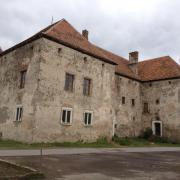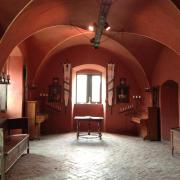The Transcarpathian Castles
The Transcarpathian castles have been built by different people in different times. If you start at “Solnce Karpat” and follow the Kyiv-Chop highway, the first castle you meet after a 15-minute drive would be the Schönborn Castle. The castle-palace of Count Schönborn has always piqued the interest of the European aristoi. The year 1890 – when it was built – is carved into every weather vane. In style, the architecture is similar to French Renaissance and follows the astronomical style, with its 365 windows – for days in a year, 12 entrances – for months, and 52 rooms – for weeks. The courtyard lake is reminiscent of the map of the Austro-Hungarian Empire in shape. Every autumn the noble guests came here to hunt, enjoy the Carpathian beauty, take a break from the boring high society life and have some fun. The local legends have it that the palace with the arboritum and the pond was a gift from the Count to his beloved wife Francisca. The Count was a very jealous person and had always suspected his wife to be cheating on him. He had suddenly returned home once, only to find his wife with the young colonel who was visiting them. Erwin-Friedrich was so enraged, he shot down the tower clock and ordered the young guest to be thrown off the highest mountain. As for his wife, the Count had a custom chandelier made: a redwood statue of Melusine with the face of the unfaithful wife and deer antlers. The chandelier was placed in the ballroom, so that all the guests could see the fruit of the Count's revenge.
The courtyard lake is reminiscent of the map of the Austro-Hungarian Empire in shape. Every autumn the noble guests came here to hunt, enjoy the Carpathian beauty, take a break from the boring high society life and have some fun. The local legends have it that the palace with the arboritum and the pond was a gift from the Count to his beloved wife Francisca. The Count was a very jealous person and had always suspected his wife to be cheating on him. He had suddenly returned home once, only to find his wife with the young colonel who was visiting them. Erwin-Friedrich was so enraged, he shot down the tower clock and ordered the young guest to be thrown off the highest mountain. As for his wife, the Count had a custom chandelier made: a redwood statue of Melusine with the face of the unfaithful wife and deer antlers. The chandelier was placed in the ballroom, so that all the guests could see the fruit of the Count's revenge.
According to other source, Melusine is a fae with a half-human half-fish body. She is a symbol representing the Count's passions: antlers for the hunt, fishtail for the fishing, woman head and body for the women.
There are many legends about this castle, so pay a visit for us to tell you all about them.
The palace area includes the mineral spring of Youth and Beauty. The legend says, washing with this water brings back youth and beauty.
The castle currently houses the administration of the “Karpaty” sanitorium.

Next on our way is the Saint Miklosh (St. Nicolas) castle in Chinadyyovo (26 km away from the cottages).  This family castle was built by Baron Perenyi in the early 15th century. Eventually the castle passed over to the Austrian count Schoenborn von Buchheim, who made it into a luxurious palace. But the icing on the castle's history cake is the secret affair between the wise countessa Ilona Zrínyi and the young count Imre Thököly (leader of the anti-Habsburg uprising). No one could hinder the small piece of happiness the two of them shared in their Castle of Love, far away from both the battlefield and the intent stares of the Austrian court. After her husband's death, Ilona, who was 39 at the time, married Imre (who was 25). Their love has even changed the fate of several peoples, and led to the formidable fortification of the Kingdom of Hungary. The locals believe that the Countessa's ghost still roams there, bringing the lovebirds together.
This family castle was built by Baron Perenyi in the early 15th century. Eventually the castle passed over to the Austrian count Schoenborn von Buchheim, who made it into a luxurious palace. But the icing on the castle's history cake is the secret affair between the wise countessa Ilona Zrínyi and the young count Imre Thököly (leader of the anti-Habsburg uprising). No one could hinder the small piece of happiness the two of them shared in their Castle of Love, far away from both the battlefield and the intent stares of the Austrian court. After her husband's death, Ilona, who was 39 at the time, married Imre (who was 25). Their love has even changed the fate of several peoples, and led to the formidable fortification of the Kingdom of Hungary. The locals believe that the Countessa's ghost still roams there, bringing the lovebirds together.
Nowadays the castle houses a marriage hall, and it truly is the best place for the clearest and pure aspirations of human souls.
Close to the Mukachevo town (30km from us) you can see the Palanok castle settled on a mountain. Although there is no data as to when it was built, the earliest mentions date back to the 11th century. The castle's fate and history is connected to Fedir Koriatovych, who received it as a gift from the Hungarian king Sigizmund in 1396. Fyodor turned the castle into his own residence. He ordered a well to be dug, 85m deep and 2,5m wide – in case of long sieges. This well has a captivating legend to it.
During the course of its history, the Palanok Castle has had numerous owners, who made different changes to the fortress' exterior. Thus in 16th century a moat (17,5m wide and 6,5m deep) was built and filled with water, while the inner circle was surrounded with strong oak fence (“palanok”) which has earned the castle its name.
The castle's history is rather complicated and has seen many a siege, the most famous of which would be the Austrian siege, which lasted for 3 years. The opposite side was headed by Ilona Zrínyi, the widow of Count Ferenc I Rákóczi, and her son. In the end, the castle surrendered due to treachery – the water in the well was poisoned. The Countessa's courage was awarded with a special certificate by the Turkish sultan. Ilona Zrínyi is the only woman to have received the highest award of the time.
And so we leave the Palanok Castle behind us to follow the road to Uzhhorod. It leads us to a magnificent citadel on a hill – the Uzhhorod Castle, which was first mentioned in the Hungarian chronicles of the IXth century (when the Ugrians were crossing the Carpathian passages). In 10-11th century the castle was under the Hungarian crown. The construction of the stone citadel began in 1248, after another Tatar-Mongol raid. In the beginning of the XIVth century it belongs to Pyotr Petenko, the Hungarian king's opponent and the leader of the anti-emperor rebels). The rebellion was unsuccessful, and two years later, in 1322, the castle was given to the French-Italian family of Drugeths. The Drugeth family were the owners of the castle for 300 years, in which the citadel was immensely fortified so that no one could seize it.
Every castle has secrets and legends of its own. One of them tells us about an unfortunate love. Count Drugeth had a beautiful daughter with long blonde hair. She was dubbed the White Maiden. Polish armies attacked our lands quite often back then. One of the Polish generals disguised himself as a guest and infiltrated the castle to discover its secrets. As soon as she saw him, the young maiden fell deeply in love for she did not know he was an enemy. And thus she saw him among the other army during a siege, but love has clouded her vision, and, despite the gravely danger and possible execution, she wanted to meet him at the gate. The news about his daughter meeting with an enemy has reached the Count. The lovers were caught and punished according to the laws of the time: the Polish general was executed while the young countess was mured alive in the castle walls.
They say the ghost of the White Maiden still haunts the castle, searching for her beloved, only to return to her stone dungeon at the sunrise.
The Uzhhorod Castle is steeped in legends, romance and its historical past; it will definitely steal a way into your heart forever.
